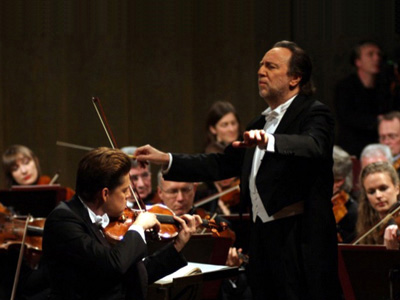By Alan Gilbert
Those of us who were involved in preparing for last year’s production of Ligeti’s Le Grand Macabre are remembering the great excitement we all felt in this very same rehearsal room as we prepare for our upcoming performances of Janáček’s opera The Cunning Little Vixen, but are also amazed at how different the space feels. This time Doug Fitch — our brilliant director/designer/costume genius — has created a fantastic, magical landscape, populated with the most gorgeous creations: animal suits, bug antennae, plants and flowers, all fashioned out of found materials and readily-available clothing. LGM (as we referred to the Ligeti) filled the studio with high-tech equipment, making it feel rather like a mad-scientists laboratory. It is a testament to Doug’s incredible range that he is able to be so convincing in such vastly varied ways. I encourage everybody to check out Doug’s Website as well as the video that was made for the Philharmonic’s site to get a real sense of this amazing artist.
During a break in rehearsal I was talking with Daniel Boico, my terrific Assistant Conductor at the Philharmonic, about how lucky we are to have a job that can be so different from day to day. The world of theater, where we are now, is a totally different experience from what our activities last week, when we were performing and recording Time Machines, Sebastian Currier’s marvelous new violin concerto with, Anne-Sophie Mutter for Deutsche Grammophon. We literally went directly from a listening session of the first edits into a staging rehearsal for the Janáček — the contrast could not have been greater.
It is difficult to believe that only two weeks ago we wrapped up our 11-concert EUROPE / SPRING 2011 Tour which took us to nine cities. Aside from the splendid playing of the Orchestra, night after night, some of my strongest memories from the tour are of the audiences — how intensely concentrated and appreciative they were, and also how distinctly different they were from place to place, from culture to culture. Audiences may not always realize how crucial they are in creating mood in a concert, and the great influence they can make on the inspiration, or lack thereof, of the performers. Many of the Philharmonic musicians were commenting on this as the tour progressed, observing that our performances experienced subtle changes over the trip according to the atmosphere we felt in the different halls.
The Budapest audience was definitely the most shocking: they have an amazing routine that involves rhythmic clapping that gradually increases in speed. Many audiences do this, but what was unusual for us was how slowly the rhythm started; the crowd began the accelerando with such long pauses between each clap that it sounded as if they had rehearsed!
All of the audiences were very quiet during the music, but there was a special intensity we felt in Leipzig; Lisa Batiashvili, one of our soloists on the tour, said that she thinks they have “cleaner ears.” Perhaps so, or perhaps not, but in any case there was a palpable connection that created a rare musical bond for all of us who were there.
But now back to rehearsing Vixen: It’s taking shape wonderfully already, and everyone is excited to hear the New York Philharmonic play this luscious score. See you there!
(For more information on Alan Gilbert and the New York Philharmonic, visit nyphil.org.)

